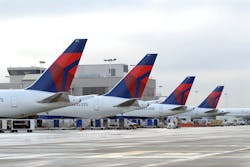LAS VEGAS -- Holden Shannon, senior vice president of airports for Delta Air Lines, used his remarks at the Boyd Group's International Aviation Forecast Summit to take a look at facilities through the lens of his carrier. By adding former Northwest Airlines hubs in Detroit and Minneapolis-St. Paul, combined with Atlanta and Salt Lake City has made the airline a powerful force, investing in airport facilities, employees and the carrier.
Delta is becoming more global, said Shannon. "With that transformation comes more connections and an international focus. For every [hub like] Memphis and Cincinnati that have receded, there's been more of a focus on gateways we can serve efficiently in Korea China, Great Britain and Mexico, where we have made friends," he explained. "Aside from larger investments in Virgin Atlantic and Aeromexico, we have jumpstarted organic growth through small investments of between five and six percent in carriers."
Delta doesn't have the depth of investment that other regions do, Shannon admitted. "The Chinese government is active in leading the growth of Chinese airports," he said. "Twenty-five years ago, Shanghai had one airport with three gates, but the build up now has been enormous. We're playing catch up, but we can also be progressive and forward-looking so we can be prepared for tomorrow.
"We see a continued investment in Atlanta, our biggest hub. It's important for the city and for Delta. The layout of the airport is state-of-the-art even after 40 years, with piers and a single-track train," said Shannon. "It's efficient for O&D and connecting traffic flow. Our second- and third-most profitable hubs are Minneapolis-St. Paul and Detroit, both cities without a competing second airports that have significant market share."
As result, a lot of facilities are catching up to where Delta and the industry are going, said Shannon. "There will be an emphasis on airside rather that land side. In Atlanta, were undergoing a $10 billion master plan that includes a sixth runway, a new terminal and a widening of the concourses," he said.
At Los Angeles International Airport, Delta completed what Shannon called a "ju-jitsu" move closer to the Tom Bradley International Terminal. "Our new facility makes it easier for our [joint venture] partners to transfer without taking a bus or passing through security again," he said. "We went from 16 to 30 gates, serving as a destination and transit point from Asia."
At LaGuardia Airport, Delta had the best facility in an aging complex, said Shannon. "We are now modernizing that airport in line with [Gov. Andrew Cuomo's] vision. The new facility will give us far more airside room and state-of-the-art facilities. We currently have 50 percent market share at LaGuardia and it's still competitive."
Salt Lake City International Airport is also going through a transformation of a sound, but aging 50-year-old facility, said Shannon. "Salt Lake City was far from the old Terminal 3 at JFK, known as a third world airport, that was torn down," he said. "Salt Lake City was far from that, but it needed a larger gauge and a more modern layout to accept growth in a more linear way than it is today."
Shannon ended with his list of future airport trends, with Airport Business magazine's observations on where these trends are already in play:
1. Terminal lobbies will require a smaller footprint: In 2007, Delta removed the traditional ticket counters in its Hartsfield hub and replaced them with self-serve kiosks and fewer counters for customers needing help 2. Security screening functions will consolidate to a central location: Delta's Terminal A at Boston-Logan International Airport has one TSA screening checkpoint, including a PreCheck line.
3. Centralized "help centers" will replace full-service podiums at each gate: It's not there yet, but you do now see phone banks at gates where passengers can call for help.
4. Airport power and data infrastructure will be more robust: Delta has added hundreds of power outlets with USB ports in its largest airports.
5. Post-security spaces will scale with higher gauge aircraft: Singapore's Changi Airport added larger hold rooms and a third jet bridge to board passengers on the upper deck of the Airbus A380.
6. Gates will flex to accommodate domestic or international aircraft: Las Vegas's McCarran International Airport has opened seven new gates in the D Concourse of Terminal 3 that can be flexed for domestic and international flights.
7. Demand for airport parking and close-in garages will diminish: Airports are allowing TNCs to pick up and drop off passengers at their terminals and offering more public transportation options.
8. Mass public transportation will connect to major airports: Denver International and Minneapolis-St. Paul International airports have light rail lines that connect directly to downtown, Baltimore-Washington International Thurgood Marshall Airport has Amtrak and commuter rail links to the city and Washington, D.C., and Atlanta's MARTA subway has a stop at Hartsfield-Jackson.



